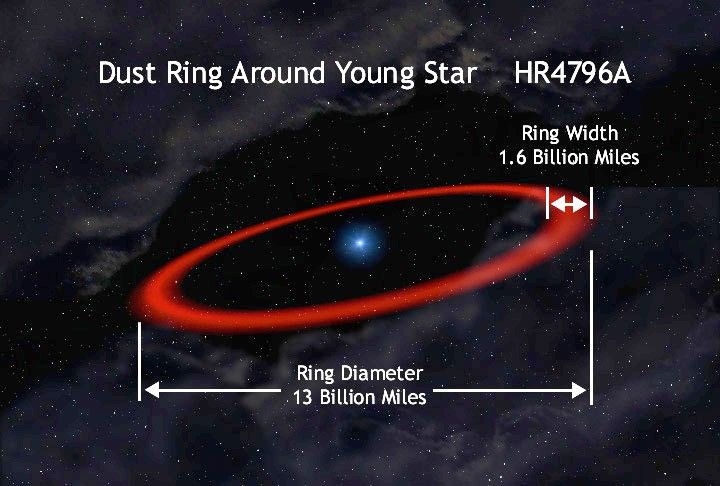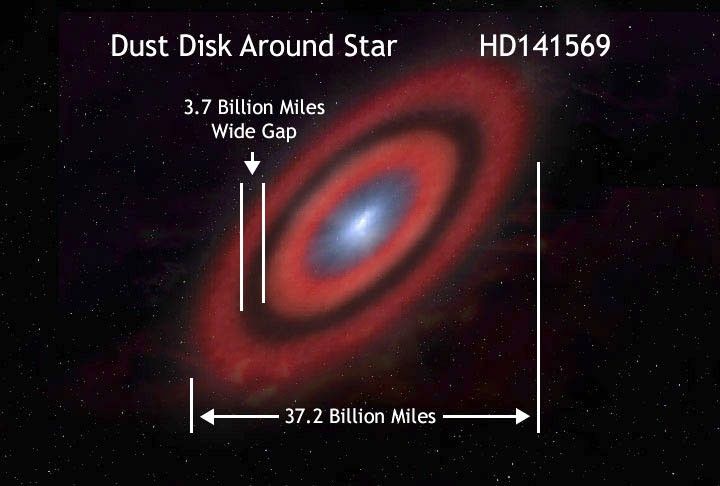1 min read
Dust Ring Around Star HR 4796A Offers New Clues Into Planet Formation

A NASA Hubble Space Telescope false-color near infrared image of a novel type of structure seen in space - a dust ring around a star. Superficially resembling Saturn's rings – but on a vastly larger scale – the "hula-hoop" around the star called HR 4796A offers new clues into the possible presence of young planets.
The near-infrared light reflecting off the dust ring is about 1,000 times fainter than the illuminating central star.
Astronomers used a coronagraphic camera on Hubble's Near Infrared Camera and Multi-Object Spectrometer (NICMOS), specifically designed to enable observations of very faint and low surface brightness objects in the close proximity to bright stars. Even with the coronagraph, the glare from HR 4796A overwhelms the much-fainter ring at distances less than about 4 billion miles (inside the blacked-out circle, centered on the star).
Hubble's crisp view was able to resolve the ring, seen at lower resolution at longer wavelengths, in ground-based thermal infrared images, as a disk with some degree of central clearing. The ring has an angular radius of 1.05 arc seconds, equivalent to the apparent size of a dime seen more than 4 miles away.
Unlike the extensive disks of dust seen around other young stars, the HR 4796A dust ring, 6.5 billion miles from the star, is tightly confined within a relatively narrow zone less than 17 Astronomical Units wide. An Astronomical Unit is the distance from the Earth to the Sun). For comparison, the ring width is approximately equal to the distance separating the orbits of Mars and Uranus in our own Solar System. All dust rings, whether around stars or planets, can only stay intact by some mechanism confining the dust, likely the gravitational tug of unseen planets.
The image was taken on March 15, 1998, centered at a near infrared wavelength of 1.1 microns. The false-color corresponds to the ring's brightness (yellow is bright, purple is faint). The ring, which is undoubtedly circular, appears elliptical since it is inclined to our line-of-sight. Thus, the apparent spacing of the ring-particles, which act as reflectors of starlight, is greatest at the ansae of the projected ellipse giving rise to the brightening in these regions.
This image is being released today at the 193rd Meeting of the American Astronomical Society in Austin, Texas.
About the Object
- R.A. PositionR.A. PositionRight ascension – analogous to longitude – is one component of an object's position.12h 36m 1.03s
- Dec. PositionDec. PositionDeclination – analogous to latitude – is one component of an object's position.-39° 52' 10.21"
- Object NameObject NameA name or catalog number that astronomers use to identify an astronomical object.HR 4796A
- Release DateJanuary 8, 1999
- Science ReleaseHubble Views of Dust Disks and Rings Surrounding Young Stars Yield Clues
- CreditCredit: Brad Smith (University of Hawaii), Glenn Schneider (University of Arizona), and NASA
Related Images & Videos

Gap in Stellar Dust Disk May Be Swept Out By Planet
A striking NASA Hubble Space Telescope near-infrared picture of a disk around the star HD 141569, located about 320 light-years away in the constellation Libra. Hubble shows that the 75 billion-mile wide disk seems to come in two parts: a dark band separates a bright inner...
Share
Details
Claire Andreoli
NASA’s Goddard Space Flight Center
Greenbelt, Maryland
claire.andreoli@nasa.gov

































